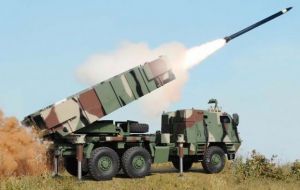MercoPress. South Atlantic News Agency
Brazil releases funds to develop surface to surface missile system for the Army
 The previous Astros system models were successfully proven in battle
The previous Astros system models were successfully proven in battle The Brazilian government gave a clear signal Monday that is intends to advance in the consolidation of a defense industry in the country. A decree signed by President Dilma Rousseff releases 45 million Real in funds for the launching of the Astros Project 2020 to equip the Brazilian army.
The project with a total value of almost 1.1 billion Real provides for the acquisition of the most advanced surface to surface missile launch system developed in Brazil. The Astros 2020 is an evolved version of the Astros II, the best selling product manufactured by Avibras Aerospace.
Exported to many countries the Astros (Artillery SaTuration ROcket System) is considered a market-leader among the small and highly competitive group of manufacturers of such systems.
Altogether the project includes the purchase of 49 vehicles by the Brazilian army divided into three batteries: 18 launch vehicles, 18 ammo re-supply vehicles, three fire control units, three weather stations, three recovery vehicles and three armoured command and control vehicles for each battery and another final vehicle for integrated command and control.
The main advantage of the new concept is the incorporation of the AV-TM, a high precision cruise missiles with a range of 300 kilometers. Unlike the rockets, which have a ballistic trajectory, defined from the impulse they receive at launch, this missile is guided and its trajectory can be controlled. Another important advance is the in the electronics system which is entirely digital.
The Astros II are normally grouped in artillery batteries consisting on average of about 13 vehicles: 6 of them are Astros II launchers, 6 are rocket resupply trucks and one a special radar-equipped vehicle controlling the fire control system. The launcher is capable of firing rockets of different calibers armed with a range of warheads.
The Astros II artillery system entered service with the Brazilian Army in 1983. The system is battle proven, having been used in action by the Iraqi Army in the Gulf Wars.
In the 1980s, Avibrás sold an estimated sixty-six Astros II artillery systems to Iraq. Iraq also built the Sajil-60 which is a license-built version of the Brazilian SS-60. Sixty Astros II were sold to Saudi Arabia and an unspecified number sold to Bahrain and Qatar. Total sales of the Astros II between 1982 and 1987 reached one billion dollars.
This fact made the Astros II multiple rocket launcher the most profitable weapon produced by Avibrás.
In the 1980s and early 1990s, Avibrás worked almost exclusively with the manufacturing of rockets and multiple-launch rocket systems (MLRS), such as the Astros II, in addition to developing antitank and anti-ship missiles. At its peak, Avibrás employed 6,000 people; later it would be reduced to 900 people in the early 1990s as the arms industry demand fell. Even so, in the first Gulf War in 1991, the Astros II was successfully used by Saudi Arabia against Iraq. Years later, the Astros II system helped Angola to defeat the UNITA rebels.




Top Comments
Disclaimer & comment rulesCommenting for this story is now closed.
If you have a Facebook account, become a fan and comment on our Facebook Page!